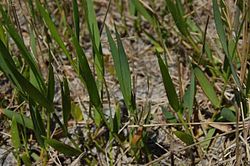| Amphicarpum | |
|---|---|
 | |
| Amphicarpum muehlenbergianum | |
| Scientific classification | |
| Kingdom: | Plantae |
| Clade: | Tracheophytes |
| Clade: | Angiosperms |
| Clade: | Monocots |
| Clade: | Commelinids |
| Order: | Poales |
| Family: | Poaceae |
| Subfamily: | Panicoideae |
| Supertribe: | Panicodae |
| Tribe: | Paniceae |
| Subtribe: | Boivinellinae |
| Genus: | Amphicarpum Kunth [1] |
| Type species | |
| Amphicarpum purshii (syn of A. amphicarpon) | |
Amphicarpum (common name maidencane) [2] is a genus of North American plants in the grass family, found only in the eastern United States. [3] [4]